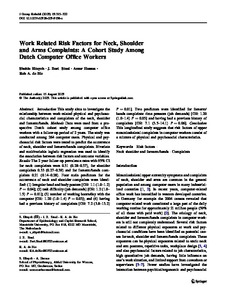Work related risk factors for neck, shoulder and arms complaints: a cohort study among Dutch computer office workers

Eltayeb, Shahla ; Staal, Bart J. ; Hassan, Amar ; de Bie, Rob A.
Journal of Occupational Rehabilitation
2009
19
4
315-322
computer work ; job exposure relation ; musculoskeletal diseases ; neck ; psychosocial risks ; occupational risks ; shoulder
Musculoskeletal disorders (MSD)
http://dx.doi.org/10.1007/s10926-009-9196-x
English
Bibliogr.
"Introduction
This study aims to investigate the relationship between work-related physical and psychosocial characteristics and complaints of the neck, shoulder and forearm/hands. Methods
Data were used from a prospective Dutch cohort study among computer office workers with a follow-up period of 2 years. The study was conducted among 264 computer users. Physical and psychosocial risk factors were tested to predict the occurrence of neck, shoulder and forearm/hands complaints. Bivariate and multivariable logistic regression was used to identify the association between risk factors and outcome variables.
Results
The 2 year follow-up prevalence rates with 95% CI for neck complaints were 0.31 (0.28–0.37), for shoulder complaints 0.33 (0.27–0.39) and for forearm/hands complaints 0.21 (0.14–0.28). Four main predictors for the occurrence of neck and shoulder complaints were identified: (1) Irregular head and body posture [OR: 1.1 (1.0–1.2) P = 0.04]; (2) task difficulty (job demands) [OR: 1.2 (1.0–1.5) P = 0.01]; (3) number of working hours/day with the computer [OR: 1.20 (1.0–1.4) P = 0.03]; and (4) having had a previous history of complaints [OR: 7.2 (3.8–13.2) P = 0.01]. Two predictors were identified for forearm/hands complaints: time pressure (job demands) [OR: 1.20 (1.0–1.4) P = 0.03] and having had a previous history of complaints [OR: 7.1 (3.5–14.1) P = 0.06].
Conclusion
This longitudinal study suggests that risk factors of upper musculoskeletal complaints in computer workers consist of a mixture of physical and psychosocial characteristics."
Digital
The ETUI is co-funded by the European Union. Views and opinions expressed are however those of the author(s) only and do not necessarily reflect those of the European Union or the ETUI.